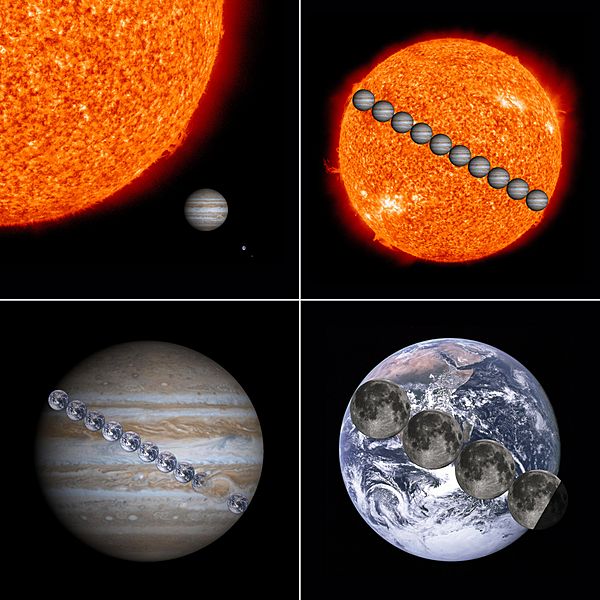Image: SolarSystem OrdersOfMagnitude Sun-Jupiter-Earth-Moon

Description: This image has four quadrants showing relative sizes of four key Solar System objects: the Sun, Jupiter, Earth and the Moon. On the top-left, all four are shown together with sizes to scale. On the top-right, Jupiter is shown to have a diameter ten times smaller (0.10045×) than the diameter of the Sun. On the bottom-left, Jupiter is shown to be eleven times (10.9733×) the diameter of the Earth. Finally on the bottom-right, the Earth is shown to be three and two-thirds (3.6676×) the diameter of the Moon. This is an 11/3 diameter ratio exactly (0.09% error). The image is titled "Solar System Orders of Magnitude" because of how, generally speaking, the diameter decreases by an order of magnitude when going from the central star, to the gas giants, to the terrestrial planets, down to the moon objects. The fourth image actually shows an unusual situation in the Solar System in that Earth's Moon is closer to its planet's size than other moons are to their planet's size (the Earth-Moon system could actually be considered a double planet). The string of eleven Earth diameters across Jupiter is purposely faded near the Great Red Spot in order to show how the Spot and the Earth have similar diameters. In reference to Jupiter itself, its Red Spot has a diameter that is one order of magnitude smaller than its own diameter. This can be extended to the size relationship of the Sun to Jupiter, that if there were a Giant Sunspot 1/10th of the Sun's diameter, then that Sunspot would have the same diameter as Jupiter. The reason why the bodies are diagrammed at an angle is because their equatorial diameters are larger than their polar diameters, especially for the gas giant, Jupiter. The size ratios depicted here are based upon their average diameters. Also, while it may appear that the bottom-left quadrant shows Jupiter's diameter as slightly smaller than 10.9733 Earth diameters, that is only because a sliver of a crescent of Jupiter is hidden in shadow - the lighting on this image is not 100% "full". NOTE: No effort was made to present the vast distances between any of these bodies to scale. This image was made using GIMP image editing software.
Title: SolarSystem OrdersOfMagnitude Sun-Jupiter-Earth-Moon
Credit: File:The Sun by the Atmospheric Imaging Assembly of NASA's Solar Dynamics Observatory - 20100819.jpg File:Jupiter by Cassini-Huygens.jpg - Note: this image of Jupiter was altered by removing the shadow of Europa. File:The Earth seen from Apollo 17.jpg File:FullMoon2010.jpg
Author: Tdadamemd
Usage Terms: Creative Commons Attribution-Share Alike 3.0
License: CC BY-SA 3.0
License Link: http://creativecommons.org/licenses/by-sa/3.0
Attribution Required?: Yes
Image usage
There are no pages that link to this image.

